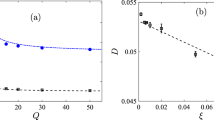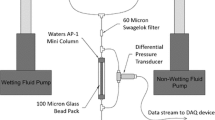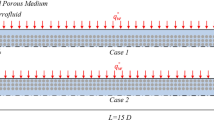Abstract
Colloidal suspensions containing magnetic nanoparticles placed in appropriate carrier liquids present strong magnetic dipoles. These suspensions, in general, exhibit normal liquid behaviour coupled with super paramagnetic properties. This leads to the possibility of remotely controlling the flow of such liquids with a moderate-strength external magnetic field. In this study, we numerically investigate the viability of controlling and steering a base-fluid with magnetic-sensitive nanoparticles into randomly structured fibrous porous media. Three dimensional flow simulations are performed using the lattice Boltzmann method. The simulation results for the flow front are presented, and the effect of the magnetic field strength on the rate of ferrofluid penetration is discussed. It is shown that the porosity of the porous medium and the size of the fibres have a strong effect on the ferrofluid penetration rate.











Similar content being viewed by others
References
Aursjø, O., Løvoll, G., Knudsen, H.A., Flekkøy, E.G., Måløy, K.J.: A direct comparison between a slow pore scale drainage experiment and a 2D lattice Boltzmann simulation. Transp. Porous Media 86, 125–134 (2011)
Berkovsky, B.M., Medvedev, V.F., Krakov, M.S.: Magnetic fluids: engineering applications. Oxford University Press, Oxford (1993)
Borglin, S.E., Moridis, G.J., Oldenburg, C.M.: Experimental Studies of Magnetically-Driven Flow of Ferrofluids in Porous Media. Report LBNL-40126. Lawrence Berkeley National Laboratory, Berkeley (1998)
Borglin, S.E., Moridis, G.J., Oldenburg, C.M.: Experimental studies of the flow of ferrofluid in porous media. Transp. Porous Media 41(1), 61–80 (2000)
Hiergeist, R., Andrä, W., Buske, N.: Application of magnetite ferrofluids for hyperthermia. J. Magn. Magn. Mater. 201(1–3), 420–422 (1999)
Horbach, J., Succi, S.: Lattice Boltzmann versus molecular dynamics simulation of nanoscale hydrodynamic flows. Phys. Rev. Lett. 96(22), 224503 (2006)
Huang, H., Thorne, D.T., Schaap, M.G., Sukop, M.C.: Proposed approximation for contact angles in Shan-and-Chen-type multicomponent multiphase lattice Boltzmann models. Phys. Rev. E 76, 066701 (2007)
Hyvaluoma, J., Koponen, A., Raiskinmaki, P., Timonen, J.: Droplets on inclined rough surfaces. Eur. Phys. J. E 23, 289–293 (2007)
Inamuro, T., Tomita, R., Ogino, F.: Lattice Boltzmann simulations of drop deformation and breakup in shear flows. Int. J. Mod. Phys. B 17, 21–26 (2003)
Janßen, C., Krafczyk, M.: Free Surface flow simulations on GPGPUs using the LBM. Comput. Math. Appl. 61(12), 3549–3563 (2011)
Jiang, F., Sousa, A.C.M.: Smoothed particle hydrodynamics modeling of transverse flow in randomly aligned fibrous porous media. Transp. Porous Media 75, 17–33 (2008)
Jiang, F., Oliveira, M.S.A., Sousa, A.C.M.: SPH simulation of transition to turbulence for planar shear flow subjected to a streamwise magnetic field. J. Comput. Phys. 217(2), 485–501 (2006)
Jiang, F., Oliveira, M.S.A., Sousa, A.C.M.: Mesoscale SPH modeling of fluid flow in isotropic porous media. Comput. Phys. Commun. 176(7), 471–480 (2007)
Kang, Q.J., Zhang, D.X., Chen, S.Y.: Displacement of a two-dimensional immiscible droplet in a channel. Phys. Fluids 14, 3203–3214 (2002)
Lallemand, P., Luo, L.-S., Peng, Y.: A lattice Boltzmann front-tracking method for interface dynamics with surface tension in two dimensions. J. Comput. Phys. 226(2), 1367–1384 (2007)
Liu, H., Zhang, Y.: Droplet formation in a T-shaped microfluidic junction. J. Appl. Phys. 106, 034906 (2009)
McCaig, M., Clegg, A.G.: Permanent Magnets in Theory and Practice, 2nd edn. Wiley, New York (1987)
Nabovati, A.: Pore level simulation of single and two phase flow in porous media using lattice Boltzmann method. Ph.D. Dissertation. University of New Brunswick, Fredericton (2009)
Nabovati, A., Sousa, A.C.M.: Fluid flow simulation at open-porous medium interface using the lattice Boltzmann method. Int. J. Numerical Method Fluids 56(8), 1449–1456 (2008)
Nabovati, A., Llewellin, E.W., Sousa, A.C.M.: A general model for the permeability of fibrous porous media based on fluid flow simulations using the lattice Boltzmann method. Composites: Part A 40, 860–869 (2009)
Nabovati, A., Llewellin, E.W., Sousa, A.C.M.: Through-thickness permeability prediction of three-dimensional multifilament woven fabrics. Composites: Part A 41, 453–463 (2010)
Odenbach, S.: Recent progress in magnetic fluid research. J. Phys. Condens. Matter. 16(32), R1135–R1150 (2004)
Oldenburg, C.M., Borglin, S.E., Moridis, G.J.: Numerical simulation of ferrofluid flow for subsurface environmental engineering applications. Transp. Porous Media 38(3), 319–344 (2000)
Pan, C., Hilpert, M., Miller, C.T.: Lattice-Boltzmann simulation of two-phase flow in porous media. Wat. Resour. Res. 40, W01501 (2004)
Raj, K., Moskowitz, R.: Commercial applications of ferrofluids. J. Magn. Magn. Mater. 85(1–3), 233–245 (1990)
Rosensweig, R.E.: Ferrohydrodynamics. Dover Publications Inc., New York (1997)
Sangani, A.S., Acrivos, A.: Slow flow through a periodic array of spheres. Int. J. Multiph. Flow 8(14), 343–360 (1982)
Schaap, M.G., Porter, M.L., Christensen, B.S.B., Wildenschild, D.: Comparison of pressure–saturation characteristics derived from computed tomography and lattice Boltzmann simulations. Wat. Resour. Res. 43, W12S06 (2007)
Shan, X., Chen, H.: Lattice Boltzmann model for simulating flows with multiple phases and components. Phys. Rev. E 47(3), 1815–1819 (1993)
Shan, X., Chen, H.: Simulation of nonideal gases and liquid–gas phase-transitions by the lattice Boltzmann-equation. Phys. Rev. E 49, 2941–2948 (1994)
Sousa, A.C.M., Jiang, F.: SPH as an inverse numerical tool for the prediction of diffusive properties in porous medium. Mater. Sci. Forum 553, 171–189 (2007)
Succi, S.: The Lattice Boltzmann Equation for Fluid Dynamics and Beyond. Oxford University Press, Oxford (2001)
Sui, Y., Low, H.T., Chew, Y.T., Roy, P.: A front-tracking lattice Boltzmann method to study flow-induced deformation of three-dimensional capsules. Comput. Fluids 39, 499–511 (2010)
Sukop, M.C., Thorne Jr, D.T.: Lattice Boltzmann Modeling: An Introduction for Geoscientists and Engineers. Springer, Berlin (2006)
Wang, X.-Q., Mujumdar, A.S.: Heat transfer characteristics of nanofluids: a review. Int. J. Therm. Sci. 46(1), 1–19 (2007)
Wolf, F.G., dos Santos, L.O.E., Philippi, P.C.: Modeling and simulation of the fluid–solid interaction in wetting. J. Stat. Mech. P06008 (2009)
Xuan, Y., Ye, M., Li, Q.: Mesoscale simulation of ferrofluid structure. Int. J. Heat Mass Transf. 48(12), 2443–2451 (2005)
Yu, D., Mei, R., Luo, L.-S.: Viscous flow computations with the method of lattice Boltzmann equation. Progr. Aerosp. Sci. 39(5), 329–367 (2003)
Zhang, J., Kwok, D.Y.: Contact line and contact angle dynamics in superhydrophobic channels. Langmuir 22, 4998–5004 (2006)
Zhang, J., Kwok, D.Y.: A mean-field free energy lattice Boltzmann model for multicomponent fluids. Eur. Phys. J. Special Top. 171, 45–53 (2009)
Acknowledgments
The authors acknowledge the support received from NSERC (Natural Sciences and Engineering Research Council of Canada) Discovery Grant 12875 (ACMS) and FCT (Foundation for Science and Technology—Portugal) Grant PTDC/EME-MFE/105031/2008 (ACMS).
Author information
Authors and Affiliations
Corresponding author
Appendix
Appendix
The local coordinate system for a magnetic field produced by a permanent magnet is shown in Fig. 12. Note that in this figure the \(z\) axis in local magnet coordinate system and that for the flow simulations are in different directions.
Local coordinate system for the magnetic field produced by a permanent magnet (Oldenburg et al. 2000)
McCaig and Clegg (1987) presented the three-dimensional relations for the magnetic field strength inside a rectangular channel, as follows:
Rights and permissions
About this article
Cite this article
Hadavand, M., Nabovati, A. & Sousa, A.C.M. Ferrofluid Permeation into Three-Dimensional Random Porous Media: A Numerical Study Using the Lattice Boltzmann Method. Transp Porous Med 99, 191–206 (2013). https://doi.org/10.1007/s11242-013-0185-3
Received:
Accepted:
Published:
Issue Date:
DOI: https://doi.org/10.1007/s11242-013-0185-3





